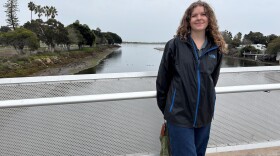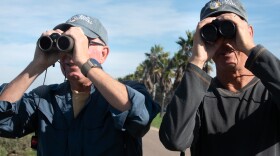At 10:21 this morning, more than seven million people across California are expected to drop cover and hold. It’s part of California’s annual earthquake drill – The Great California Shakeout. The event comes at time when scientists are warning a large-scale earthquake is long overdue.
Southern California and Mexico have seen a surge in moderate-sized earthquakes this year. Seismologists say the activity is normal for this earthquake-prone region. Most of the quakes have been aftershocks to the 7.2 Easter earthquake, but there have also been several magnitude-fours and fives on unrelated faults.
WHAT TO DO DURING AN EARTHQUAKE
If Indoors
- DROP to the ground; take COVER by getting under a sturdy table or other piece of furniture; and HOLD ON until the shaking stops.
- Stay away from glass, windows, outside doors and walls, and anything that could fall, such as lighting fixtures or furniture.
- Stay in bed if you are there when the earthquake strikes. Hold on and protect your head with a pillow, unless you are under a heavy light fixture that could fall. In that case, move to the nearest safe place.
- Use a doorway for shelter only if it is in close proximity to you and if you know it is a strongly supported, loadbearing doorway.
- Stay inside until the shaking stops and it is safe to go outside. Research has shown that most injuries occur when people inside buildings attempt to move to a different location inside the building or try to leave.
- Be aware that the electricity may go out or the sprinkler systems or fire alarms may turn on.
- Do not use elevators.
If outdoors
- Stay there.
- Move away from buildings, streetlights, and utility wires.
- Once in the open, stay there until the shaking stops. Most earthquake-related casualties result from collapsing walls, flying glass, and falling objects
The quakes have rattled the nerves of residents and jolted scientists into action to try to determine where the next big one will strike.
UC Irvine seismologist Lisa Grant Ludwig has her eye on the southern San Andreas fault. "This section of the fault has accumulated as much strain, basically as much energy as it released in the last big one in 1857," said Ludwig.
Ludwig is part of a team of researchers who studies trenches along the Carrizo section of the San Andreas – about 100 miles north of Los Angeles. She said scientists believed the Carrizo section was like a road block. An earthquake would stop there because it wasn’t due to rupture for another 100 years.
"And what we showed is, well, the Carrizo Plain has ruptured more often than anybody thought before," Ludwig explained, "and yes the Carrizo Plain could go too. So you could potentially have this falling dominoes leading to a big earthquake.
Ludwig said the entire 340-mile southern section of the fault -- from Monterey County to the Salton Sea -- could slip all at once and trigger a massive, magnitude-8.1 quake that could last from one-and-a-half to three minutes.
"These findings kind of put the exclamation point on what we already know, is that we have a high probability of a damaging earthquake and this emphasizes that. It looks like it’s worse than what we previously thought,” she said.
Public safety officials hope the recent quakes will motivate residents to prepare.
Students at San Diego's Taft Middle School recently experienced a magnitude-7.8 jolt in an earthquake simulation drill. They practiced dropping to the floor, taking cover under a table or desk and holding on until the shaking stopped. County of San Diego spokeswoman Yvette Moe said that’s the protocol emergency officials are urging residents to practice.
"We found out during the Easter quake that so many people didn’t know what to do," said Moe. "And that’s why it’s so important to drill, because if they don’t drill they don’t react instinctively when a real emergency happens."
Scientists say the San Andreas isn’t the only loaded fault in California.
Eric Fielding, a geophysicist at the Jet Propulsion Laboratory in Pasadena said the Easter earthquake built up pressure on the San Jacinto Fault, California’s most active fault that runs through parts of San Diego -- from Imperial County to San Bernadino.
San Diegans were shaken when the San Jacinto produced a magnitude-5.4 on July 7.
"A 5.4 is a drop in the bucket when it comes to these major fault systems,” warned Fielding.
Fielding said it would take hundreds of magnitude five quakes to alleviate enough pressure on the fault to prevent a major earthquake. Fielding uses airborne radar to look for signs that other faults might break.
"By using two images, one image acquired before the earthquake and one image acquired after the earthquake, we’re able to do a type of subtraction called interferometry," explained Fielding. And that allows us to measure the earth’s surface deformation between the two images to quite a high accuracy."
Fielding said data from the last flight showed the Easter quake moved the Calexico region in a downward and southerly direction up to 31 inches in some places.
"It’s clear that large earthquakes cause changes in stress on nearby faults,” said Thomas Rockwell, professor of Geological Sciences at San Diego State University. Rockwell added that a large earthquake on the San Jacinto fault would affect the stress on the San Andreas, and vice-versa.
"Depending on what sections of the fault are near failure and which are increased in accumulated stress after an earthquake, then we may expect to have additional earthquakes, or not," He added, "It depends on whether they’re increased or decreased, because you can have both effects.”
Rockwell said the recent seismic activity has provided scientists a goldmine of data, but the big question remains -- when? He said a large rupture could happen at any moment or it could be 30 years from now.
"What we can say is, these faults are ripe. They really look like they can fail in the near future," warned Rockwell.
Lisa Ludwig likes to use the analogy that when you see clouds on the horizon, you bring an umbrella. She said the earthquake data is giving residents a chance to take action.
"I like to say don’t get scared, get prepared," said Ludwig. "It doesn’t really help to worry because we can’t stop earthquakes."












